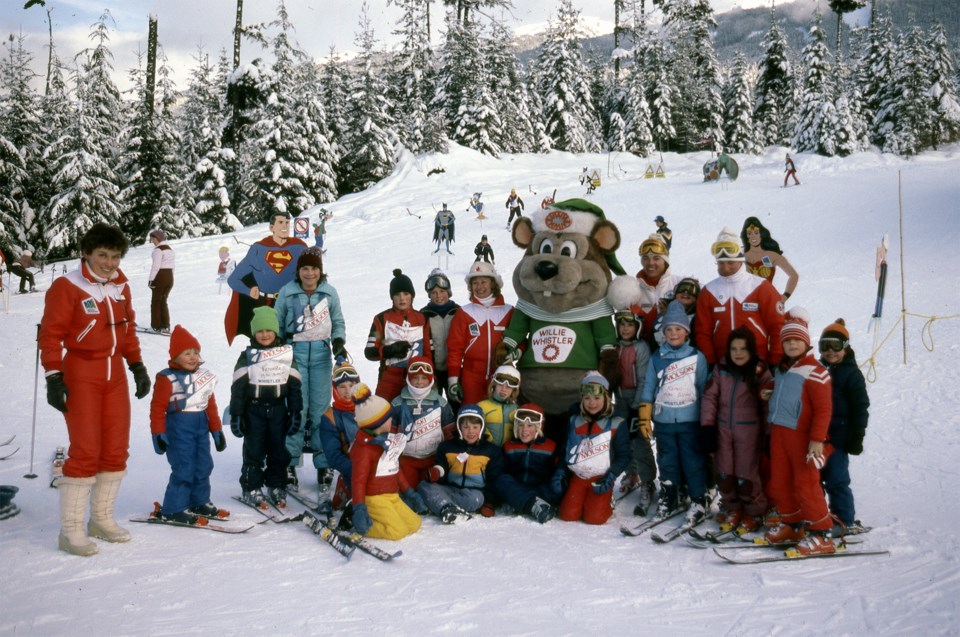In the 1980s and ’90s, two trademarked symbols of the Whistler Resort Association (WRA, now doing business as Tourism Whistler) could frequently be seen around town: a circle of Ws and a marmot named Willie Whistler.
The circle of Ws was originally developed for the Whistler Village Land Company (WVLC) in 1978 by Robert McIlhargey (an architectural illustrator) and his colleagues Dave Clifford and Lori Brown. Whistler Village was not yet built at the time, but the logo was soon in use around the valley, such as on signs at the Whistler Village site.
In 1979, Don Willoughby and Geoff Power of Willpower Enterprises were given permission to produce 1,000 T-shirts using the logo as souvenirs of the World Cup race that didn’t run on Whistler Mountain. Similarly, the WRA later allowed members, corporate supporters, and members-at-large to use the logo. Though they did charge for commercial use, it cost nothing for members to add the circle of Ws to their business cards and signs.
The WVLC did not survive the recession of the early 1980s, but the logo did, and was used widely by the WRA. In the Jan. 3, 1985 issue of the Whistler Question, the circle of Ws was referred to by Stew Muir as “the official Whistler insignia,” and it was so popular the WRA was beginning to “clamp down” on its unofficial use by other parties.
Looking back on his work in 1985, McIlhargey described the concept behind the logo. The design team reportedly decided to work with a circle because it was “a neat and tidy way of doing a symbol.” According to McIlhargey, the result was ideal for a four-season resort because “it could be winter or it could be summer. In one sense it’s a snowflake, and in another you see a sunburst.”
For the typeface of any words beneath the Ws, they chose Frankfurter, because “it’s friendly, soft and looks a bit like a cornice or snow,” he added.
The design guidelines developed with the logo suggested that in the “best circumstances,” the logo would be red with a silver background; however, most people are probably more familiar with it in white against a contrasting background, such as the wood of highway and Village signs.
By 1985, the circle of Ws could be found on signs, turtlenecks, letterheads, and the T-shirt and hat of Willie Whistler. Willie Whistler was developed as the WRA’s mascot in 1981. The marmot, known as the source of Whistler’s name, was named by eight-year-old Tammi Wick in a naming contest (she won a Blackcomb season pass for her idea) and introduced to the public at the first Fall Festival. From then, Willie Whistler could be found at most events in the resort.
The mascot was reportedly trademarked in order to “prevent a doll manufacturer from reproducing mini-Willies without permission.”
When listing ideas for dolls of Willie Whistler, suggestions included “Willie golfing, Willie playing tennis, Willie meeting Barbie,” and more. He did, in fact, do most of these things (or close to them) during his time as Whistler’s mascot. Willie Whistler golfed with Arnold Palmer, competed in ski races, presented awards, and met visiting celebrities and dignitaries, including touring Whistler Village with then-Prime Minister Pierre Trudeau and his son Justin in 1982.
Both the circle of Ws and Willie Whistler were still in use into the 1990s, though Willie Whistler’s appearances were becoming less frequent. Today, the Willie Whistler costume is lost to the landfill, and both the logo and the name of the WRA have changed. You can still find circles of Ws throughout Whistler, however, whether on a few original signs in the village (take a look up at the buildings on Skiers Approach), now-vintage clothing, or some bridges on trails throughout the valley. You can find more recent production of the logo on mugs and shirts available at the Whistler Museum with permission to use the trademark or, this past summer, on hats from the Whistler Golf Club to celebrate its 40th anniversary.




